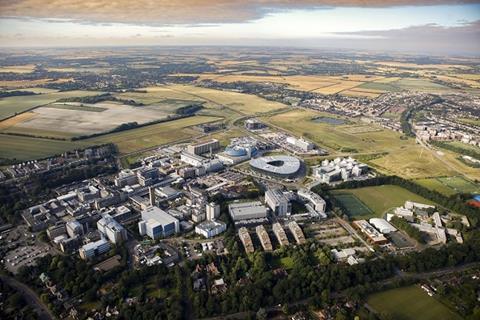The British life sciences industry is attracting record levels of investment and now housing developers are looking to take advantage of the opportunities
When considering the impact of the pandemic on business it is difficult to think of too many winners. The virus which has taken millions of lives, led to lockdowns across the globe, and taken a huge toll on sectors of the economy.

But one area certainly seems to be growing rapidly and may even have emerged stronger from the chaos, particularly in the UK. The life sciences sector, which includes fields such as biology, microbiology and biochemistry, has been booming over the past few years and was given a shot in the arm by the country’s widely acclaimed effort in producing covid-19 vaccines.
According to research last year by JLL, there is up to £15bn of capital allocated to UK life sciences real estate of which less than 10% has been deployed. Nearly a quarter (23%) of the £65bn allocated globally for life sciences is in the UK.
Investors who may have had their fingers burnt through investing in other industries in the pandemic are keen to look for greater security, while environmental, social and governance impact investors may also be attracted by the sector.
The UK government has launched a £200m life sciences investment programme while British Patient Capital is working with the Abu Dhabi Mubadala Investment Company which has committed £800m to the UK’s life sciences industry.
All of this will mean new life sciences campuses, including laboratories and offices, as well extensions of existing facilities.
The life sciences facilities in the “golden triangle” of London, Cambridge and Oxford are getting ever bigger with the planned £450m planned Cambridge Biomedical Campus extension, built by San Francisco-based Prologis, adding 400,000ft2 of office and laboratory space alone. The boom is not restricted to London, with life sciences sectors emerging in other cities around the United Kingdom, including Bristol, Manchester, Leeds, Nottingham as well as Edinburgh, Aberdeen and Glasgow.
This rapid expansion is also leading to some serious thought among investors and housing developers about how to take advantage of the demand. So what kind of residential investment and development opportunities and housing products are we likely to see?
The golden triangle
One giant master developer thinking very carefully about the life sciences market and how it links up with housing is British Land. The £524m-turnover company’s mammoth project to build 3,000 homes at Canada Water, south-east London, includes three million square feet of flexible commercial space that it hopes will attract businesses from the life sciences sector.
Emma Cariaga, joint head of Canada Water development and head of residential at British Land, said: “Around one third of the homes at Canada Water are affordable, which leaves us 2,000 homes to deliver, and we think this will include some intermediate rent products to cater for ‘keyworker’ housing for those working in the life sciences.”

British Land is now also in talks with employers in the Oxford, Cambridge, London “golden triangle” about ways of providing housing specifically tailored to those working in life sciences in the region.
Cariaga says: “If you are [company such as] Pfizer or Unilever trying to persuade talent to come and work in Cambridge, you are competing with lots of countries around the world who are also trying to be the centre of the life sciences, not least North America.” Cariaga says Boston, in the United States has successfully used the co-existence of homes and life sciences space to attract talent.
She says employers in the Ox-Cam area have told her they have identified a “gap in the market” for intermediate rental housing near life sciences campuses for workers who earn too much for affordable housing but too little for mainstream housing. This would be akin to discounted keyworker housing for public sector workers but with shared amenities and a high-quality rental offer.
Life sciences is a growth area, it’s not something that’s been in the local plan for 10 or 15 years. It’s kind of a windfall new sector
Cariaga says: “That’s a type of housing that’s not on the whole being provided for in local plans by local authorities, where their focus and their greatest need is undoubtedly at the lower end of the affordable spectrum in terms of social rent.”
She says local authorities do, however, need to come up with new policies to cater for this demographic. She says: “Remember that life sciences is a growth area, it’s not something that’s been in the local plan for 10 or 15 years. It’s kind of a windfall new sector.”
Cariaga very much sees the housing opportunity consisting of homes targeted at life sciences workers close to, or adjacent to, work spaces, allowing workers to easily go to and from laboratories from home at all hours.
Wider housing opportunities

However, others see the opportunity as being broader. Neil Bidwell, partner at property consultancy Bidwells is currently working with a landowner who has land surrounding an expanding Cambridge life sciences campus. He says more work needs to be done to understand the housing opportunities from the life sciences boom.
He says: “Having the housing constituted all on the campus may put some people off, who don’t want to live too near work.” In the case of Cambridge, the proposed Cambridge South train station and line will connect the area with London, Stansted airport and Birmingham, to allow people to commute.
Similarly, he says some people may want to buy rather than rent, so a “one size fits all” may not be best approach.
Housing association giant Sovereign is also eyeing up development opportunities in towns south of Oxford that have life sciences campuses. Mark Washer, chief executive of the 60,000-home housing association, says: “There are a number of significant developments in and around Abingdon, for example, and Didcot that we are actively involved in.”
Washer added that the affordability gap in and around Oxford is “almost as bad” as in some of the more expensive parts of London.
The interest in housing to cater for life science workers is not just focused on the “golden triangle” though.
One of the more eye-catching development initiatives announced last year was a new partnership between build-to-rent specialist Moda Living and global private real estate developer Osborne & Co.
Under this partnership, build-to-rent housing will be delivered alongside life sciences development, with hundreds of millions of pounds targeted at cities including Glasgow, Leeds, Edinburgh and Birmingham.
The first project under this initiative is the 500-home Belfast Waterside scheme (pictured, top). Moda will acquire a two-acre site from Osborne to deliver a £150m neighbourhood, which will sit alongside 1.2million m2 of office, technology and innovation space.
We’ve got a real shared demographic in terms of target market
Oscar Brooks, board director at Moda Living, sees a synergy between the move towards “innovation space” in offices and the desire for more flexible living, especially among the 25 to 35 years age bracket.
He said: “We spend millions of pounds to create that space and opportunity for people to interact, to innovate, to connect and that seems to go hand in hand with the ethos of what the Osborne guys are trying to do with their office space and their life science approach. We’ve got a real shared demographic in terms of target market.”
For Brooks, the offer for life sciences employees is for convenience in the form of a “highly amenitised, highly serviced” environment, which also allows space to work from home. “It becomes more of a shared campus type approach,” he said.
The UK life sciences boom is in its infancy but the sheer amount of investment is leading to housing developers, businesses, universities and investors having serious conversations about the likely resulting housing development opportunities within the “golden triangle” and other major cities around the country. It may take some time before we know exactly what form this new housing opportunity takes and whether distinctive products emerge.
But get it right, and housing developers could play a huge role in helping the UK attract and retain life sciences workers in an increasingly competitive market, while at the same time driving lucrative returns.
>> Also read: Stanton Williams lands Canada Water life-sciences project
















No comments yet